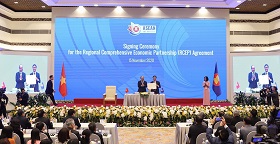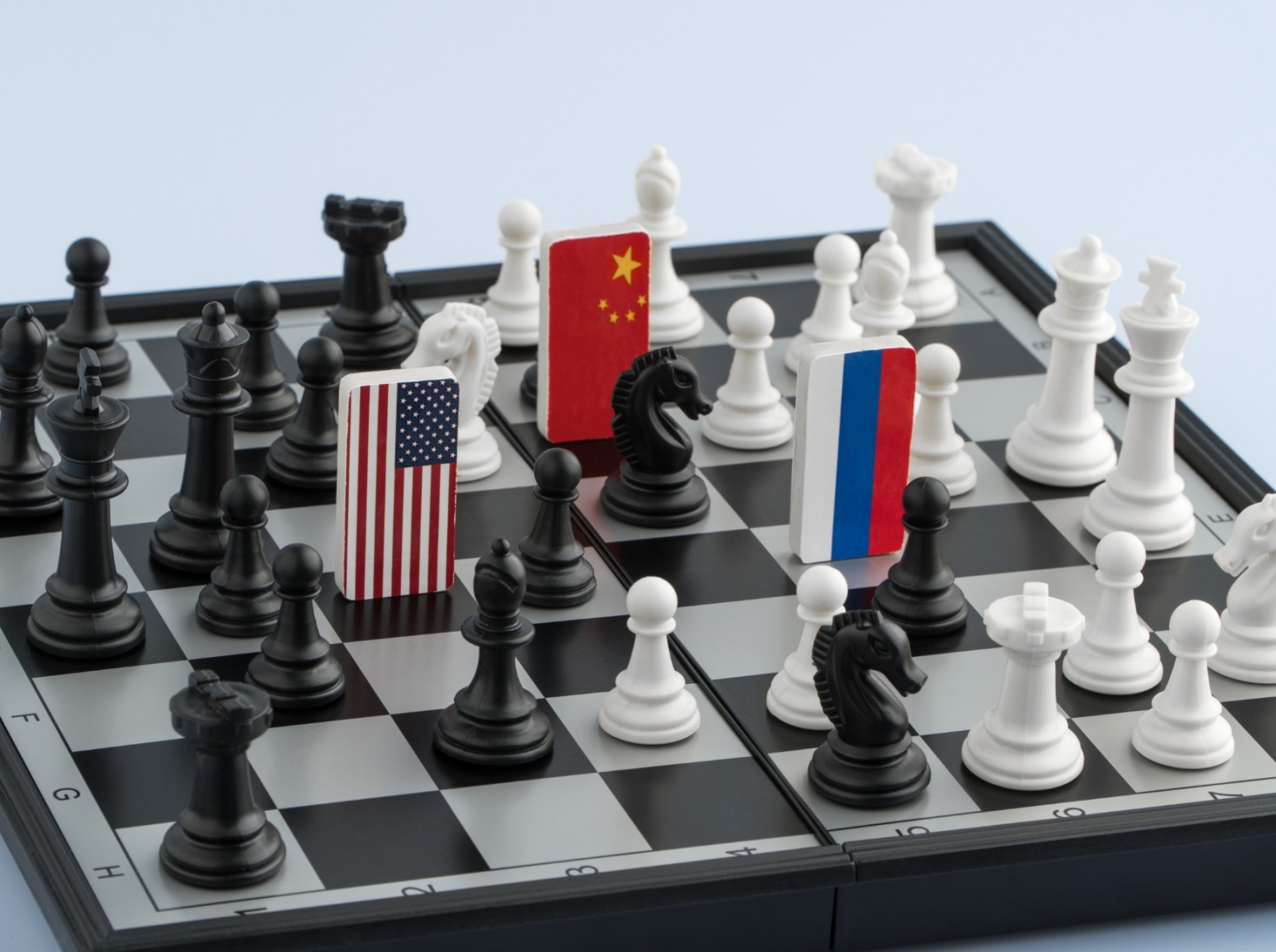The role of global economy’s engine returns back to Asia. Over the past decades, the weight of East and South-East Asian countries in the system of international economic relations has been steadily growing. More than half of the world's population is concentrated there. China has already come out on top in the world with its GDP in terms of purchasing power parity/PPP (by 2028, it is predicted that this will happen at par), India may rank third (after the United States) in terms of PPP as early as 2023. Asia accounts for 38 percent of world GDP. According to the McKinsey Global Institute, as of September 2019, Asia's share in world trade was 33 percent, in investment—23 percent, in patents—65 percent, in container transportation—62 percent, energy production—29 percent and energy consumption—43 percent.
The East is moving closer to the West in terms of GDP per capita: for China, it is 30 percent (in terms of PPP) of the US level and 44 percent of the EU level; India has 20 percent of the EU level. The share of exports in China's GDP fell from 16 percent to 8 percent between 2007 and 2018. A similar process is taking place in India. Already half of the global middle class lives there, while it has collapsed in recent decades in the West as a result of market globalisation. This trend reflects the ongoing process of industrialisation and urbanisation, growth in labour productivity and the dynamic development of the corporate sector. Indian Prime Minister Narendra Modi said at a recent meeting of the Asian Infrastructure Investment Bank that “the continent finds itself at the centre of global economic activity. It has become the main growth engine of the world. In fact, we are now living through what many have termed the Asian Century.
At the same time, Asia is catching up with the West in terms of such problems as sustainable growth, inequality and environmental protection, which makes these countries indispensable partners in countering those challenges at a global level. It is hard not to conclude that we are witnessing a historical convergence between East and West. Moreover, these processes here, and also globally, do not carry the risk of conflicts, as was the case with the historical rise of the West over the last two centuries, precisely because of the difference in cultures.
Unlike the US/EU, the Asia-Pacific has been mostly able to keep the pandemic under control and is now trying to restore their economies as quickly as possible. An important step was the signing of the Regional Comprehensive Economic Partnership between 10 ASEAN countries, as well as five partner countries (China, Japan, South Korea, Australia and New Zealand) during the online summit held on November 16, 2020. The ratification of the document, which will take two years, will result in the establishment of the largest free trade zone in the world. China’s assessment of this event speaks volumes: a “victory of multilateralism and free trade.” The partnership will provide Beijing with an opportunity to strengthen relations with many of its neighbours and start working towards resolving existing conflicts.
Russia did not stand aloof when the global development trends pointed towards the West. We can’t help being part of the global pendulum’s movement in the opposite direction.
It is striking that public discussions on the country's foreign policy, including numerous TV talk shows, are almost exclusively focused on the problems of our relations with the US/EU and developments in the post-Soviet space. It is quite clear that these are the most acute topics, fraught with sensations, and the problems of our neighbours, with whom we are closely connected, and not only by common history, can’t help giving the public opinion reasons for concern. But in the end, an inadequate and distorted picture of Russian diplomacy is taking shape, while one of its basic principles says that it ought to be multi-directional.
It is also true that East Asia, the entire Asia-Pacific region makes comparatively less “noise” and attracts less attention. But this is precisely one of its advantages: there is more stability both domestically and internationally. The states in the region have learned to establish close ties among themselves based on mutual respect and equality. The ASEAN member states set the tone, surely playing a system-forming role in all regional projects and projecting their political culture and practice—the so-called ASEAN way—onto them.
And that happens at the time when, after the West’s 150-year-long domination, the combined result of the Industrial Revolution and the creation of colonial empires, the role of global economy’s engine returns back to Asia. Thus, a highly competitive environment is being created between the West and the East, and the twain, contrary to Rudyard Kipling's dogma, meet on the basis of trade and investment, as well as free competition in technology. However, during the Trump presidency, the United States embarked on a course of deglobalisation and recreation of a kind of CoCom of the Cold War era, in order to maintain the illusion of its technological superiority and to isolate China, labelling it “US biggest geopolitical challenge” (nominee for CIA director William J. Burns at the Senate hearings), following the logic of Thucydides' trap and zero-sum games. In fact, the practice of the Cold War, as well as the geostrategic and ideological postulates of the past continue to serve as the main source of tensions in this vast region.
There are also local problems, including territorial conflicts (the Indo-Pakistani conflict in Kashmir, the Indo-Chinese conflict in the Himalayas, those of contested ownership of islands in the South China and East China Seas, and a number of others). But they do not create global tension if the old geopolitics in the spirit of the Great Games of the 19th century is not projected onto a given situation. It is obvious that the main instigator here is Washington, relying on its old alliances and trying to reproduce a policy of containment in the region, in particular, through the creation of closed dialogue platforms, such as the Indo-Pacific Quad of the US, India, Australia and Japan. But such a “grand strategy” seems to have few prospects. Not least of all, due to the fact that the Asia-Pacific convexly reproduces a multipolar environment that is characteristic of the modern world in general. There are at least four such poles here—along with the United States and China, these are India and Russia that plays an important balancing role, interacting with Beijing and New Delhi in the trilateral RIC format and within the BRICS, as well as bilaterally.
Over the past decades, the weight of East and South-East Asian countries in the system of international economic relations has been steadily growing. More than half of the world's population is concentrated there. China has already come out on top in the world with its GDP in terms of purchasing power parity/PPP (by 2028, it is predicted that this will happen at par), India may rank third (after the United States) in terms of PPP as early as 2023. Asia accounts for 38 percent of world GDP. According to the McKinsey Global Institute, as of September 2019, Asia's share in world trade was 33 percent, in investment—23 percent, in patents—65 percent, in container transportation—62 percent, energy production—29 percent and energy consumption—43 percent.
The East is moving closer to the West in terms of GDP per capita: for China, it is 30 percent (in terms of PPP) of the US level and 44 percent of the EU level; India has 20 percent of the EU level. The share of exports in China's GDP fell from 16 percent to 8 percent between 2007 and 2018. A similar process is taking place in India. Already half of the global middle class lives there, while it has collapsed in recent decades in the West as a result of market globalisation. This trend reflects the ongoing process of industrialisation and urbanisation, growth in labour productivity and the dynamic development of the corporate sector. Indian Prime Minister Narendra Modi said at a recent meeting of the Asian Infrastructure Investment Bank that “the continent finds itself at the centre of global economic activity. It has become the main growth engine of the world. In fact, we are now living through what many have termed the Asian Century.”
It is also equally important that intra-regional trade is growing, including production chains, oriented towards growth in domestic consumption (which already accounts for about 40 percent of the global consumption). Numbers can prove the success of such regionalisation, which is a powerful factor ensuring the sustainable development of these countries: about 60 percent of their international trade is bilateral, as well as 71 percent of investment in startups and 59 percent of direct foreign investment. Also, 74 percent of air passengers travel within the region. In general, self-sufficiency is growing, and the complementarity of economies stimulates the integration process and the formation of powerful economic networks.
At the same time, Asia is catching up with the West in terms of such problems as sustainable growth, inequality and environmental protection, which makes these countries indispensable partners in countering those challenges at a global level. It is hard not to conclude that we are witnessing a historical convergence between East and West. Moreover, these processes here, and also globally, do not carry the risk of conflicts, as was the case with the historical rise of the West over the last two centuries, precisely because of the difference in cultures.
Unlike the US/EU, the Asia-Pacific has been mostly able to keep the pandemic under control and is now trying to restore their economies as quickly as possible. An important step was the signing of the Regional Comprehensive Economic Partnership between 10 ASEAN countries, as well as five partner countries (China, Japan, South Korea, Australia and New Zealand) during the online summit held on November 16, 2020. The ratification of the document, which will take two years, will result in the establishment of the largest free trade zone in the world. China’s assessment of this event speaks volumes: a “victory of multilateralism and free trade.” The partnership will provide Beijing with an opportunity to strengthen relations with many of its neighbours and start working towards resolving existing conflicts.
The partnership also includes provisions on intellectual property, telecommunications, financial services and e-commerce. Unlike the EU, RCEP members do not set uniform labour and environmental standards, nor do they oblige member states to open up vulnerable areas of their economies. Thanks to these flexible rules, the agreement simultaneously serves the interests of a wide range of countries in the region, from Myanmar and Vietnam to Singapore and Australia. According to Jeffrey Wilson, research director at the Perth USAsia Centre, RCEP promises to be “an important platform for the recovery of the Indo-Pacific region after the COVID-19 pandemic.”
New Delhi played an active part in the development of RCEP, so the doors of the partnership remain open to it. The new arrangement does not include the United States, which showed no interest in RCEP even at the discussion stage. It is noteworthy that America’s allies signed the document without waiting for the new US president to take office. In other words, the “caravan moves on” despite and contrary to the old geopolitical imperatives.
In recent years, a lot of positive trends have been gaining strength in East Asia: the role of the power factor in security policy is decreasing, and the military and political situation is becoming more stable and predictable. The countries in the region have come a long way in their mutual relationships while gradually getting rid of stereotypes of confrontation and mutual distrust. Apparently, in the near future Afghanistan will remain a destabilising factor, which will require that the regional players seek a regional solution to this regional conflict, one way or another.
Moreover, turning the region into a stage of geopolitical confrontation is unacceptable. This is another reason for Russia’s involvement in the region’s affairs, because we are as much a part of it as of Europe, not to mention that Russia/USSR historically was the channel of European civilisation spreading Eastwards. Russia did not stand aloof when the global development trends pointed towards the West. We can’t help being part of the global pendulum’s movement in the opposite directon.






